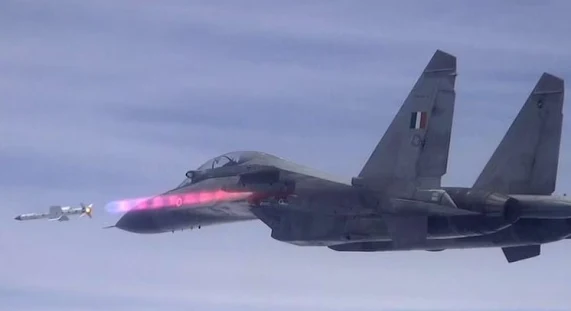 |
| Astra MK! missile test fired from a Su-30 fighter of the IAF |
International Military - The Indian Ministry of Defense has recently awarded a contract of 424 million dollars for the procurement of long-range missiles, the Astra MK1. Bharat Dynamics Ltd is the company entrusted with supplying the Astra MK1 Beyond Visual Range (BVR) missile to the country's air force.
In the contract, the Indian Ministry of Defense requested 400 of these Astra MK1 missiles for its air force within the next four years, quoted from Defense Security Asia. The original Indian-made BVR Astra MK1 missile will be fitted to their fighter aircraft fleet.
Read Also: Highly Flexible, India's Astra BVR Missiles Can Be Paired With Russian Fighters
Call it the Su-30MKI, Tehas, and MiG-29K, as well as other fighter aircraft. The development of this local missile aims to reduce dependence on foreign products. Considering the global scale economic sanctions that Russia is currently experiencing, it is difficult for importing countries to get military spare parts from that country.
As additional information, this Astra MK1 missile will later replace the role of the Russian R-77 missile currently used by the Su-30MKI and MiG-29K fleets. India claims that its missiles are much more accurate and have a wider range than Russian missiles.
The R-77 BVR missile only has an effective range of 80 km, while the Astra MK1 can hit targets as far as 100 km, citing Defense Security Asia. With a longer range, of course the Astra MK1 missile will give the Indian Air Force an advantage in carrying out long-range attacks.
Missile Beyond Visual Range (BVR) Astra MK1
The Astra-MK1 is the first BVR missile developed by India, designed and developed by the Defense Research and Development Organization (DRDO). The BVR missile is designed to destroy aerial targets with high maneuverability and supersonic speed, citing the First Post.
In short, the capabilities of the Astra MK1 missile allow it to strike multiple high-performance targets. Development of this BVR missile was officially approved in the early 2000s and its first phase or MK1 was completed in 2017.
Astra MK1 has a length of 3.57 meters and a diameter of 178 mm, effectively reaching targets at 80 to 110 km traveling at a speed of Mach 4.5. The missile also has a locally developed Ku-band active radar guidance system and a 15 kg warhead.
According to the First Post, the price per unit of the original locally made Indian missile is much cheaper than the Russian, French and Israeli BVR missiles they are currently using. One of the selling points of the Astra MK1 BVR missile is its highly effective performance, capable of destroying targets with just one shot in both head-on and tail-chase modes.
Procurement of MK2 and MK3
It seems that India's defense sector is in luck, the Defense Research and Development Organization (DRDO) informed that it is developing a new missile. Scientists at DRDO are working on building the Astra MK2 and 3 BVR missiles, citing Defense View.
"We are developing the latest versions of missiles (MK2 and 3) which are capable of striking targets at a distance of 160 km and 300 km," said a senior DRDO official, Friday, June 10, 2022.
And for the test launch, the MK2 will be tested in 2023 while the MK3 will conduct trials in 2024. The Astra MK3 BVR missile is based on the Solid Fuel Ducted Ramjet (SFDR) engine which was developed jointly with India and Russia.
The development program for the third version of the Astar BVR missile aims to rival the PL-15, AIM-260 JATM and MBDA Meteor missiles which have a range of 350 km, Defense View reports.
"Future combat is about detecting and striking targets at the furthest distances, this is the sweet fruit of technological development of radar detection at this time it is important for India to develop the Astra MK2 and 3 to increase the long-range strike power of its armed forces," said Air Marshal Anil Chopra ( retired).
